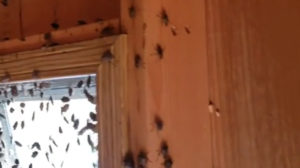 Finding bugs in the kitchen can get devastating and is an invitation to different diseases. Pantry pests can infest mostly all of the items which include grains, dried fruit. To avoid pest infestation in the kitchen, you should ensure that you keep all your food sealed tightly. Here are the top pantry pests and how to get rid of them:
Finding bugs in the kitchen can get devastating and is an invitation to different diseases. Pantry pests can infest mostly all of the items which include grains, dried fruit. To avoid pest infestation in the kitchen, you should ensure that you keep all your food sealed tightly. Here are the top pantry pests and how to get rid of them:
8 Pantry Pests
Indian Meal Moth
Indian meal moth is a small insect which has two-tone wings. These pests can enter your home through flour, and pasta packages from the grocery store. Even though a female moth has a life of less than a week, it can do damage by laying more than 300 eggs near the food which can further damage your food.
Weevil
Weevils can grow around 2 millimeters, however, the adult females can lay around 4 eggs every day which can cause a nuisance in your kitchen. You can usually find them in barley, corn, oats, and rice. It is advised to throw out the product as weevils can further affect your home and spread infestation.
Cigarette Beetle
Cigarette beetles can feed tobacco products, and other pantry items such as nuts, pet food, and cereals. You can even find them in dried herbs and spices. They can find their ways through open windows, cracks, however, they can come inside your home through infested products.
Warehouse Beetle
Warehouse beetles are oval-shaped pantry pests which you can find in grains, pet foods, and even cereal. They can contaminate and even infest your food which can cause diseases.
Spider Beetle
Spider beetles are mainly drawn towards different foods kept in cupboards and pantries. They not only destroy the food packages but also destroy the areas by webbing.
Pharaoh Ants
Pharaoh ants are known to feast on sweets, proteins, and fats, and can be found in every other household. These ants are about 1/16 inch long and can survive in warm areas, and large colonies. They are one of the most common household pests that feast on the sweet food and carry diseases.
Saw-Toothed Grain Beetle
The saw-toothed grain beetle can feast on different staples in your kitchen which include candy, pet food, and even fruits. This beetle can feed on the food inside your pantry.
Yellow Mealworm
Yellow mealworms can infest a food product that is stored in your pantry for too long. As adults, yellow mealworms look similar to typical beetles. Even though they are not known to transmit any disease but can cause gastric discomfort.
How To Get Rid Of Pantry Pests?
Protecting your homes from bad bugs and pests can become a task, however, by following these steps you can get rid of them.
- Check All The Food Packages Carefully
Regularly check all the food packages stored in the pantry and cupboards carefully, especially flour, rice and other grain-derived products. Remember bugs can be really small and squeeze their way in, so make sure to properly stir around and check for infestation.
- Throw Away The Infested Food
If there is contaminated food in your pantry, ensure to throw it away to stop from further infestation. It is advised that you keep no open packages in your kitchen as bugs can lay eggs in open packages, thus, inviting diseases.
- Go For Pest Control
If there is a high pest infestation in your pantry, ensure to go for pest control. As professional pest control companies will be involved in the process, you won’t have to face any trouble. However, it is recommended to thoroughly research all the pest providers in your area and choose the perfect one.
- Clean The Shelves
Clean all the shelves and corners of your home regularly. You can even take the help of a vacuum cleaner to clean the left bugs or cocoons, along with grains or spilled crumbs.
Conclusion
Pantry pest infestations can lead to different diseases and more, so make a point to follow the above points to get rid of them completely. Also, one thing that you should always do is not to store open food packets in the kitchen. Take proper precautions so that you can decrease the pest infestation in no time.


